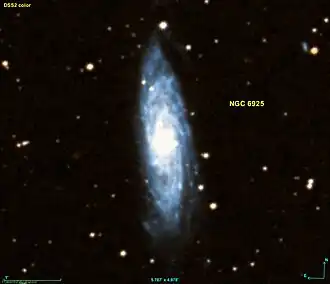NGC 6925
| NGC 6925 | |
|---|---|
 | |
| Observation data (J2000 epoch) | |
| Constellation | Microscopium |
| Right ascension | 20h 34m 20.566s[1] |
| Declination | −31° 58′ 51.20″[1] |
| Redshift | 0.009317[1] |
| Heliocentric radial velocity | 2780.1 km/s[1] |
| Distance | 99.62 ± 13.57 Mly (30.543 ± 4.162 Mpc)[2] |
| Apparent magnitude (V) | 11.3[1] |
| Apparent magnitude (B) | 12.09[1] |
| Characteristics | |
| Type | SA(s)bc[2] |
| Apparent size (V) | 3.100′ × 1.116′[1] |
| Other designations | |
| IC 5015, MCG-05-48-022, PGC 64980, IRAS 20312-3209[2] | |
NGC 6925 is an unbarred spiral galaxy in the constellation Microscopium of apparent magnitude 11.3. It is lens-shaped, as it lies almost edge on to observers on Earth. It lies 3.7 degrees west-northwest of Alpha Microscopii.[3]
SN 2011ei, a Type II supernova in NGC 6925, was discovered by Stu Parker in New Zealand in July 2011.[4]
References
- ^ a b c d e f g "NGC 6925". SIMBAD. Centre de données astronomiques de Strasbourg. Retrieved 25 March 2015.
- ^ a b c "NED results for object NGC 6925". National Aeronautics and Space Administration / Infrared Processing and Analysis Center. Retrieved 13 February 2017.
- ^ Bakich, Michael E. (2010). 1001 Celestial Wonders to See Before You Die: The Best Sky Objects for Star Gazers. Patrick Moore's Practical Astronomy Series. Springer. p. 289. ISBN 978-1-4419-1776-8.
- ^ "Supernova 2011ei in NGC 6925". Rochester Astronomy. Archived from the original on 20 June 2015. Retrieved 20 June 2015.